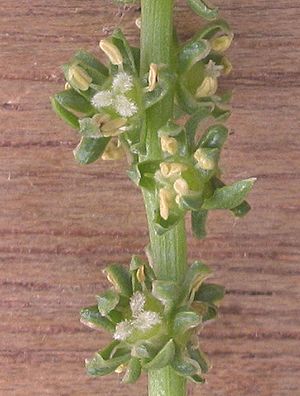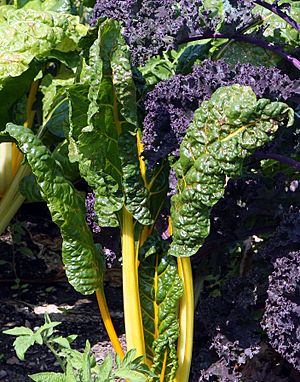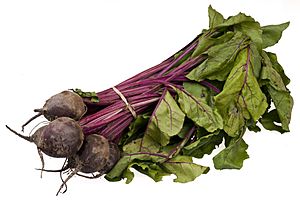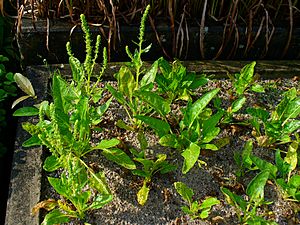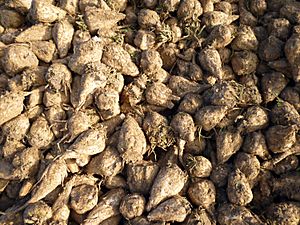Beet (plant) facts for kids
Quick facts for kids Beet (plant) |
|
|---|---|
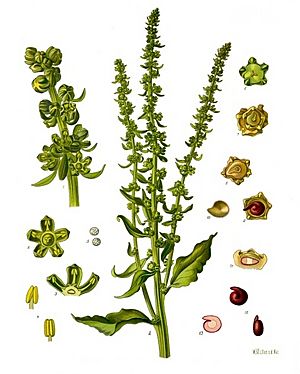 |
|
| A common beet plant | |
| Scientific classification |
Beta vulgaris is the scientific name for the plant we commonly call beet. It's a type of flowering plant that belongs to the same family as spinach and quinoa. Beets are super important because they give us many useful crops.
Some of the most well-known types of beets include:
- Sugar beet: This is used to make the sugar we eat every day.
- Beetroot (or garden beet): This is the red root vegetable often found in salads or cooked dishes.
- Chard (or spinach beet): This type is grown for its tasty leaves.
- Mangelwurzel: This is a large beet grown to feed farm animals.
All these different kinds of beets come from a wild plant called the sea beet.
Contents
What Beets Look Like
Beets are usually plants that live for two years (biennials). In their first year, they grow leaves and a root. In their second year, they grow a tall stem with flowers and seeds. Some wild beets can live longer.
The roots of cultivated beets can be dark red, white, or yellow. They are often big and fleshy. Wild beets have thinner, brown roots. The stems grow straight up and can be quite tall, sometimes over 1 meter (about 4 feet) high.
The leaves at the bottom of the plant are large and can be dark green or dark red. They have a thick stem (petiole) that can also be red, white, or yellow in some types. The leaves are a bit thick and usually have a clear vein down the middle.
Beet flowers are small and grow in clusters along the stem. They are usually green or a bit reddish. Each flower has five small parts, five stamens (which make pollen), and a part that will become the seed. Bees and other insects, as well as wind, help pollinate the flowers.
After the flowers are pollinated, they form hard clusters of seeds. The seeds are small, flat, and shiny, usually reddish-brown.
| Stereo image
|
||
|
||
|
||
|
||
|
||
| Beet seeds |
Where Beets Grow
Wild beets are found along the coasts of Europe, the Mediterranean Sea, North Africa, and parts of Western Asia. They like to grow on rocky beaches, in salty marshes, or in disturbed areas near the coast.
Cultivated beets are grown all over the world, especially in places that don't have very cold winters. They prefer cool temperatures, around 15 to 19 degrees Celsius (59 to 66 degrees Fahrenheit). Beets can handle salty soil and dry weather because their wild ancestors grew near the sea. They grow best in soil that is not too acidic and has important nutrients like sodium and boron.
Types of Beets
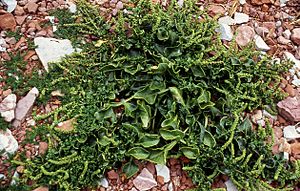
Scientists group beets into different types called subspecies. There are three main subspecies of Beta vulgaris:
- Beta vulgaris subsp. adanensis : This type grows in parts of Southeast Europe and Western Asia.
- Beta vulgaris subsp. maritima : This is the wild ancestor of all the beets we grow today. It grows along the coasts of Western Europe and the Mediterranean.
- Beta vulgaris subsp. vulgaris : All the cultivated beets we eat belong to this subspecies. They are divided into five main groups:
-
- Sugar Beet (Altissima Group)
The sugar beet is a very important crop. Its roots contain a lot of sugar, which is used to make table sugar. People in Germany discovered in the late 1700s that beetroots had sugar, and then they developed the sugar beet we know today.
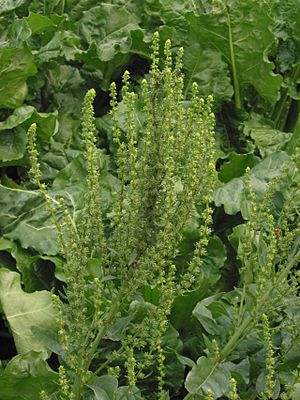
-
- Spinach Beet or Chard (Cicla Group)
This group of beets is grown for its leaves. People have been growing leafy beets for a very long time, even thousands of years ago. They were first grown in the Mediterranean area and later spread to the Middle East and Asia. In ancient Greece and medieval Europe, they were used as medicine. Today, their leaves are often cooked like spinach.
-
- Swiss Chard (Flavescens Group)
Swiss chard has thick, fleshy stems (midribs) and large leaves. Both the stems and the leaf blades are eaten as vegetables. Some types of Swiss chard are also grown because their colorful stems look pretty in gardens.
-
- Beetroot or Garden Beet (Conditiva Group)
This is the red root vegetable that most people think of when they hear "beet." It's very popular in Eastern Europe, where it's a main ingredient in soups like Borscht. You can bake, boil, or steam beetroots, eat them in salads, or pickle them.
-
- Mangelwurzel (Crassa Group)
This type of beet was developed in the 1700s. It grows very large roots that are used to feed farm animals.
What Eats Beets?
Many types of caterpillars (the larvae of butterflies and moths) like to eat beet plants.
How We Use Beets
Food
Beets are a healthy food! In a 100-gram serving (about half a cup), raw beets have about 43 calories. They are mostly water (88%) and contain carbohydrates (10%), protein (about 2%), and very little fat. Beets are a good source of folate and manganese, which are important vitamins and minerals for your body.
- The leaves of spinach beet and young garden beets can be cooked and eaten like spinach.
- The thick stems of Swiss chard are often cooked separately from the leaves.
- The deep-red roots of garden beets can be baked, boiled, steamed, or eaten raw in salads. They are also often pickled.
- In Eastern Europe, beet soup, like borscht, is a very popular dish.
- Sometimes, after eating red beets, some people might notice their urine turns pink. This is normal and harmless!
- Jewish people traditionally eat beets on Rosh Hashanah (New Year) as a symbol of removing bad things.
Traditional Uses
For a long time, people have used beet roots and leaves in traditional medicine to help with different health issues. For example, ancient Romans used beetroot to help with fevers and constipation.
Other Uses
Some types of beets have large, brightly colored leaves, so people grow them in gardens just because they look pretty!
Growing Beets
Beets are grown for many reasons: to feed animals (like mangelwurzel), to make sugar (sugar beet), for their leaves (chard), or for their roots (beetroot).
Some beetroots have an "earthy" taste. This comes from a natural substance called geosmin. Scientists are working to grow new types of beets that have less of this taste, so more people will enjoy them.
Beets need a lot of a nutrient called boron to grow well. This might be because their wild ancestors grew near the sea, where they were always exposed to sea spray containing boron. If beets don't get enough boron, their growth can be stunted.
Red Color of Beets
The beautiful red or purple color of beetroot comes from special pigments called betalains. Most other red plants get their color from different pigments called anthocyanins. The exact mix of betalain pigments can vary, which is why you can find yellow or other colored beetroots, not just deep red ones.
These pigments are stored inside the plant cells. When you cut or cook red beetroots, the cells can break, and the pigments can leak out, which is why beets can stain your hands or cutting board! If you leave the skin on when cooking, it helps keep the color inside.
History of Beets
The wild sea beet grew naturally along the coast of the Mediterranean Sea. People have found very old beet remains in ancient sites, suggesting that beets have been around for a long time. The earliest written mention of beets is from Mesopotamia, about 2,800 years ago. Ancient Greek thinkers like Theophrastus and Aristotle also wrote about beets.
For most of history, people mainly grew beets for their leaves, like chard. The ancient Romans thought beets were a very healthy food. Later, in medieval Europe, beetroots became more commonly grown.
The Story of the Sugar Beet
The modern sugar beet has an interesting history! In the mid-1700s in Germany, scientists were trying to find new ways to get sugar. In 1747, a scientist named Andreas Marggraf discovered that sugar could be taken from beetroots, and it was the same sugar as from sugarcane.
His student, Franz Karl Achard, worked to find the best beet variety for sugar. He found a local type of beet that had about 6% sugar. This special beet, called 'White Silesian Sugar Beet', is the ancestor of all sugar beets grown today.
The first factory to get sugar from beets opened in 1801 in what is now Poland. The sugar beet then came to France. During the Napoleonic Wars, when it was hard to get sugar from sugarcane (which came from tropical places), Napoleon encouraged people to grow sugar beets. This helped the sugar beet industry grow very quickly in Europe.
By 1880, more than half of the world's sugar came from sugar beets! Today, sugar beets are still a very important crop for making table sugar.
See also
 In Spanish: Remolacha para niños
In Spanish: Remolacha para niños


